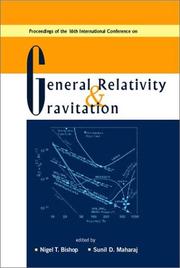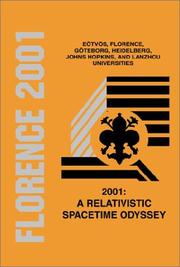| Listing 1 - 10 of 152 | << page >> |
Sort by
|
Book
ISBN: 9781108488396 1108488390 Year: 2020 Publisher: Cambridge: Cambridge university press,
Abstract | Keywords | Export | Availability | Bookmark
 Loading...
Loading...Choose an application
- Reference Manager
- EndNote
- RefWorks (Direct export to RefWorks)
"Spacetime and Geometry is an introductory textbook on general relativity, specifically aimed at students. Using a lucid style, Carroll first covers the foundations of the theory and mathematical formalism, providing an approachable introduction to what can often be an intimidating subject. Three major applications of general relativity are then discussed: black holes, perturbation theory and gravitational waves, and cosmology. Students will learn the origin of how spacetime curves (the Einstein equation) and how matter moves through it (the geodesic equation). They will learn what black holes really are, how gravitational waves are generated and detected, and the modern view of the expansion of the universe. A brief introduction to quantum field theory in curved spacetime is also included. A student familiar with this book will be ready to tackle research-level problems in gravitational physics"--
Book
ISBN: 1107032865 9781107032866 9781139507486 Year: 2014 Publisher: Cambridge Cambridge University Press
Abstract | Keywords | Export | Availability | Bookmark
 Loading...
Loading...Choose an application
- Reference Manager
- EndNote
- RefWorks (Direct export to RefWorks)
"This textbook explores approximate solutions to general relativity and their consequences. It offers a unique presentation of Einstein's theory by developing powerful methods that can be applied to astrophysical systems. Beginning with a uniquely thorough treatment of Newtonian gravity, the book develops post-Newtonian and post-Minkowskian approximation methods to obtain weak-field solutions to the Einstein field equations. The book explores the motion of self-gravitating bodies, the physics of gravitational waves, and the impact of radiative losses on gravitating systems. It concludes with a brief overview of alternative theories of gravity. Ideal for graduate courses on general relativity and relativistic astrophysics, the book examines real-life applications, such as planetary motion around the Sun, the timing of binary pulsars, and gravitational waves emitted by binary black holes. Text boxes explore related topics and provide historical context, and over 100 exercises present challenging tests of the material covered in the main text"--
Book
ISBN: 1527545180 9781527545182 1527544281 9781527544284 Year: 2020 Publisher: [Place of publication not identified] CAMBRIDGE SCHOLARS PUBLIS
Abstract | Keywords | Export | Availability | Bookmark
 Loading...
Loading...Choose an application
- Reference Manager
- EndNote
- RefWorks (Direct export to RefWorks)
Book
ISBN: 9781108954082 1108954081 9781108957519 110895751X 9781108957717 1108957714 9781009517782 9781108949286 Year: 2024 Publisher: Cambridge : Cambridge University Press,
Abstract | Keywords | Export | Availability | Bookmark
 Loading...
Loading...Choose an application
- Reference Manager
- EndNote
- RefWorks (Direct export to RefWorks)
This Element provides a somewhat comprehensive interpretation of general relativity, a description of what reality would be like if the theory were true. This concerns (i) what possibilities it represents, (ii) the internal structure of those possibilities and their interrelations, and, to some extent, (iii) how those possibilities differ from what's come before. By providing an interpretive foil that one can amplify or amend, it aspires to shape the research agenda in the foundations of general relativity for established philosophers of physics, graduate students searching for work in these topics, and other interested academics. This title is also available as Open Access on Cambridge Core.
Book
ISBN: 0387978135 3540978135 Year: 1992 Publisher: New York : Springer,
Abstract | Keywords | Export | Availability | Bookmark
 Loading...
Loading...Choose an application
- Reference Manager
- EndNote
- RefWorks (Direct export to RefWorks)
Astrophysics. --- General relativity (Physics) --- Cosmology.

ISBN: 1281929204 9786611929206 9812776559 9789812776556 9812381716 9789812381712 9781281929204 Year: 2002 Publisher: Singapore River Edge, NJ World Scientific
Abstract | Keywords | Export | Availability | Bookmark
 Loading...
Loading...Choose an application
- Reference Manager
- EndNote
- RefWorks (Direct export to RefWorks)
The 16th conference of the International Society on General Relativity and Gravitation (GR16), held at the International Convention Centre in Durban, South Africa, from 15 to 21 July, was attended by 450 delegates from around the world. The scientific programme comprised 18 plenary lectures, 1 public lecture and 19 workshops which, excepting 3 plenary lectures, are presented in this proceedings. It was the first major international conference on general relativity and gravitation held on the African continent.
General relativity (Physics) --- Gravitation --- Gravitational waves

ISBN: 9812791361 9789812791368 9789812380890 9812380892 Year: 2003 Publisher: River Edge, N.J. World Scientific
Abstract | Keywords | Export | Availability | Bookmark
 Loading...
Loading...Choose an application
- Reference Manager
- EndNote
- RefWorks (Direct export to RefWorks)
This volume offers a comprehensive overview of our understanding of gravity at both the experimental and the theoretical level. Critical reviews by experts cover topics ranging from astrophysics (anisotropies in the cosmic microwave background, gamma ray bursts, neutron stars and astroparticles), cosmology, the status of gravitational wave sources and detectors, verification of Newton's law at short distances, the equivalence principle, gravito-magnetism, measurement theory, time machines and the foundations of Einstein's theory, to string theory and loop quantum gravity.
General relativity (Physics) --- Particles (Nuclear physics)
Multi
ISBN: 9783031179648 9783031179631 9783031179655 9783031179662 Year: 2023 Publisher: Cham Springer International Publishing :Imprint: Springer
Abstract | Keywords | Export | Availability | Bookmark
 Loading...
Loading...Choose an application
- Reference Manager
- EndNote
- RefWorks (Direct export to RefWorks)
The thesis tackles two distinct problems of great interest in gravitational mechanics — one relativistic and one Newtonian. The relativistic one is concerned with the "first law of binary mechanics", a remarkably simple variational relation that plays a crucial role in the modern understanding of the gravitational two-body problem, thereby contributing to the effort to detect gravitational-wave signals from binary systems of black holes and neutron stars. The work reported in the thesis provides a mathematically elegant extension of previous results to compact objects that carry spin angular momentum and quadrupolar deformations, which more accurately represent astrophysical bodies than mere point particles. The Newtonian problem is concerned with the isochrone problem of celestial mechanics, namely the determination of the set of radial potentials whose bounded orbits have a radial period independent of the angular momentum. The thesis solves this problem completely in a geometrical way and explores its consequence on a variety of levels, in particular with a complete characterisation of isochrone orbits. The thesis is exceptional in the breadth of its scope and achievements. It is clearly and eloquently written, makes excellent use of images, provides careful explanations of the concepts and calculations, and it conveys the author’s personality in a way that is rare in scientific writing, while never sacrificing academic rigor.
Astrophysics --- Geophysics --- zwaartekracht --- astrofysica --- General relativity (Physics)
Multi
ISBN: 9783031237621 9783031237614 9783031237638 9783031237645 Year: 2023 Publisher: Cham Springer Nature Switzerland :Imprint: Springer
Abstract | Keywords | Export | Availability | Bookmark
 Loading...
Loading...Choose an application
- Reference Manager
- EndNote
- RefWorks (Direct export to RefWorks)
This book investigates Lorentzian structures in the four-dimensional space-time, supplemented either by a covector field of the time-direction or by a scalar field of the global time. Furthermore, it proposes a new metrizable model of gravity. In contrast to the usual General Relativity theory, where all ten components of the symmetric pseudo-metric are independent variables, the gravity model presented here essentially depends only on a single four-covector field, and is restricted to have only three-independent components. However, the author proves that the gravitational field, governed by the proposed model and generated by some massive body, resting and spherically symmetric in some coordinate system, is given by a pseudo-metric that coincides with the well known Schwarzschild metric from General Relativity. The Maxwell equations and electrodynamics are also investigated in the framework of the proposed model. In particular, the covariant formulation of electrodynamics of moving dielectrics and para/diamagnetic media is derived.
Geophysics --- zwaartekracht --- General relativity (Physics) --- Quantum electrodynamics.
Multi
ISBN: 9783031089350 9783031089343 9783031089367 9783031089374 Year: 2022 Publisher: Cham Springer International Publishing :Imprint: Springer
Abstract | Keywords | Export | Availability | Bookmark
 Loading...
Loading...Choose an application
- Reference Manager
- EndNote
- RefWorks (Direct export to RefWorks)
Our vast Universe is filled with an enormous amount of matter and energy, which are the source of large gravitational potentials affecting all physical phenomena. Because this fact about the size and contents of the Universe was not known when our fundamental theories of dynamics and relativity were completed by the 1920s, the current theories - based as they are in empty space - fail to incorporate cosmic gravity. Though the current theories are consistent with the majority of empirical facts, there are some crucial discrepancies, which demand a drastic shift to a cosmic gravitational paradigm for the theories of relativity and dynamics. The book is a detailed and widely accessible account of this paradigm, called Cosmic Relativity, supported by ample empirical evidence. It is established that all motional relativistic effects are cosmic gravitational effects. The new theory of Cosmic Relativity solves and answers all outstanding questions and puzzles about dynamics and relativity.
Cosmology --- Geophysics --- zwaartekracht --- kosmologie --- General relativity (Physics)
| Listing 1 - 10 of 152 | << page >> |
Sort by
|

 Search
Search Feedback
Feedback About UniCat
About UniCat  Help
Help News
News